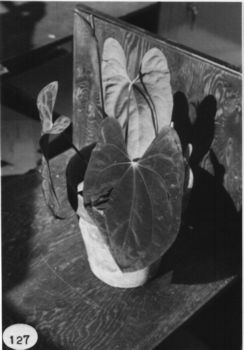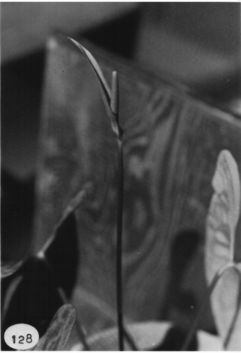


Anthurium papillilaminum Croat, sp. nov.
TYPE: Panama. Colón: hill slope in Achiote, Dressler 6033 (MO 2927339, holotype; US, isotype).
Plants terrestris; cataphyllum basi findens, apice persistens intactum; petiolus subteres, 16.5-34 cm longus, leviter sulcatus; lamina modice membranacea, oblongo-ovata ad anguste ovata, basi cordata, 25-43 cm longa, 11.5-26 cm lata, pagina superiore velutina; inflorescentia erecta et effusa, foliis longiore; pedunculus teres, 28.5-54 cm longus; spatha modice membranacea, viridis suffusa rubro-violaceae, lanceolata, 6.3-12 cm longa, 0.8-1.8 cm lata, stipite 4-14 mm longo; spadix viridis, 3-13.5 cm longus; baccae ignotae.
Terrestrial; stems ca. 10 cm long, ca. 3 cm diam.; leaf scars 2.5 cm wide; roots green, medium thick, descending; cataphylls 4-6 cm long, drying brown (B & K Yellow 4/2.5), persisting intact at apex, splitting at base.
LEAVES with petioles erect-spreading, sometimes the blade held parallel to petiole; petioles 16.5-34 cm long, 4ų6 mm diam., subterete, sometimes very shallowly sulcate, dark olive green, sometimes tinged reddish to red-violet; geniculum 1-1.5 cm long, pale green at base of blade or sometimes tinged red-violet; blades oblong-ovate to narrowly ovate, moderately thin, acuminate at apex (the acumen flat), lobed at base, 25-43 cm long, 11.5-26.5 cm wide; anterior lobe 19-30.4 cm long, the margins rounded; posterior lobes 6.5-13.5 cm long; sinus hippocrepiform to nearly triangular, rounded to acute at apex; both surfaces matte, densely papillate; upper surface deep green, velvety, lower surface pale olive green; midrib narrowly and acutely raised above, diminished and flat toward apex, narrowly and acutely raised below; basal veins 4-5 pairs, the first and second free to the base, those remaining coalesced 0.5-1 cm, paler than surface and raised above, flat to weakly raised below, sometimes tinged reddish; posterior ribs naked, the outer margin turned up; primary lateral veins 3-4 per side, departing midrib at 35-45° angle; usually straight to collective vein, prominulous above, flat below; interprimary veins scarcely visible above, conspicuous below; collective vein arising from the first basal vein, forming an acute angle with the margin, sunken above, raised below, 1.5-3.5 cm from the margin.
INFLORESCENCE erect-spreading, longer than leaves; peduncle 28.5-54 cm long, 3-6 mm diam., terete, heavily tinged red-violet, one and a half to two times longer than the petioles; spathe moderately thin, green tinged with red-violet, lanceolate, 6.3-12 cm long, 0.8-1.8 cm wide, broadest near the base, gradually acuminate at apex, obtuse and unequal at base, inserted at ca. 30° angle on peduncle; stipe 4-14 mm long, faintly tinged red-violet; spadix green (B & K Yellow-green 6/10), tapered toward apex, 3-13.5 cm long, 4.5-9 mm diam. near base, 3-4 mm diam. at apex; flowers sub-4-lobed 2-2.9 mm long, 2.3-3 mm wide, the sides straight to jaggedly sigmoid, 5-6 flowers visible in the principal spiral, 4-8 flowers visible in the alternate spiral; tepals matte to semiglossy, minutely papillate; lateral tepals 0.8-1.5 mm wide, the inner margin obtusely angular to concave; pistils emergent, green; stigma linear-elliptic, brush-like, drying brown; stamens emerging from the base, the laterals emerging nearly to apex before the alternates emerge; anthers cream, held against pistil at edge of tepals, ca. 0.5 mm long, 0.8 mm wide; thecae oblong, not divaricate; pollen cream-colored.
INFRUCTESCENCE not seen. Figs. 127 and 128.
Anthurium papillilaminum is known from central Panama and eastern Darien Provinces near the Colombian border from sea level to 100m.
The species is a member of section Cardiolonchium and is characterized by its terrestrial habit, its dark blackish green, velvety leaf blade with only slightly paler major veins, and by its inflorescence with a green spadix held well above the leaves. It is closest to Anthurium crystallinum, which differs by having an epiphytic habit, a yellowish spadix, and a pale area along its major veins (midrib and basal veins). The latter has been collected only on Cerro Pirre in Panama, while A. papillilaminum is known only from lower elevations in the region of the isthmus.
Anthurium papillilaminum is largely known from cultivated material and has been collected in the wild for certain only near Achiote (west of the Panama Canal near sea level) and along the Río Guanche at less than 100 m. A collection of unknown origin (Newbill 1) is perhaps also this species. It differs in that it is reported to have a yellow spadix.
 |
 |
Panama :, , Cirino 8 (NY, US).
Panama :, , Croat 78302 (MO).